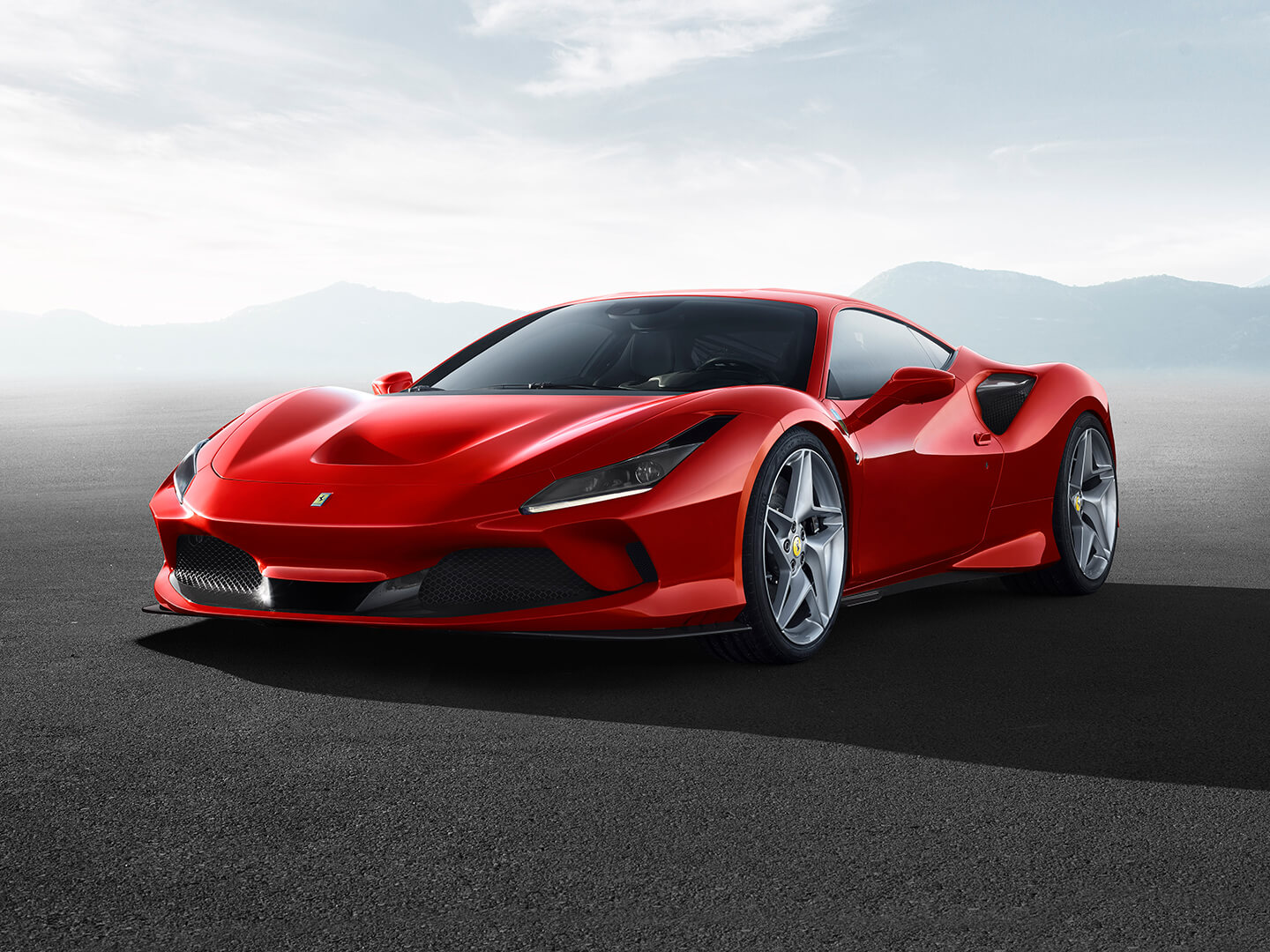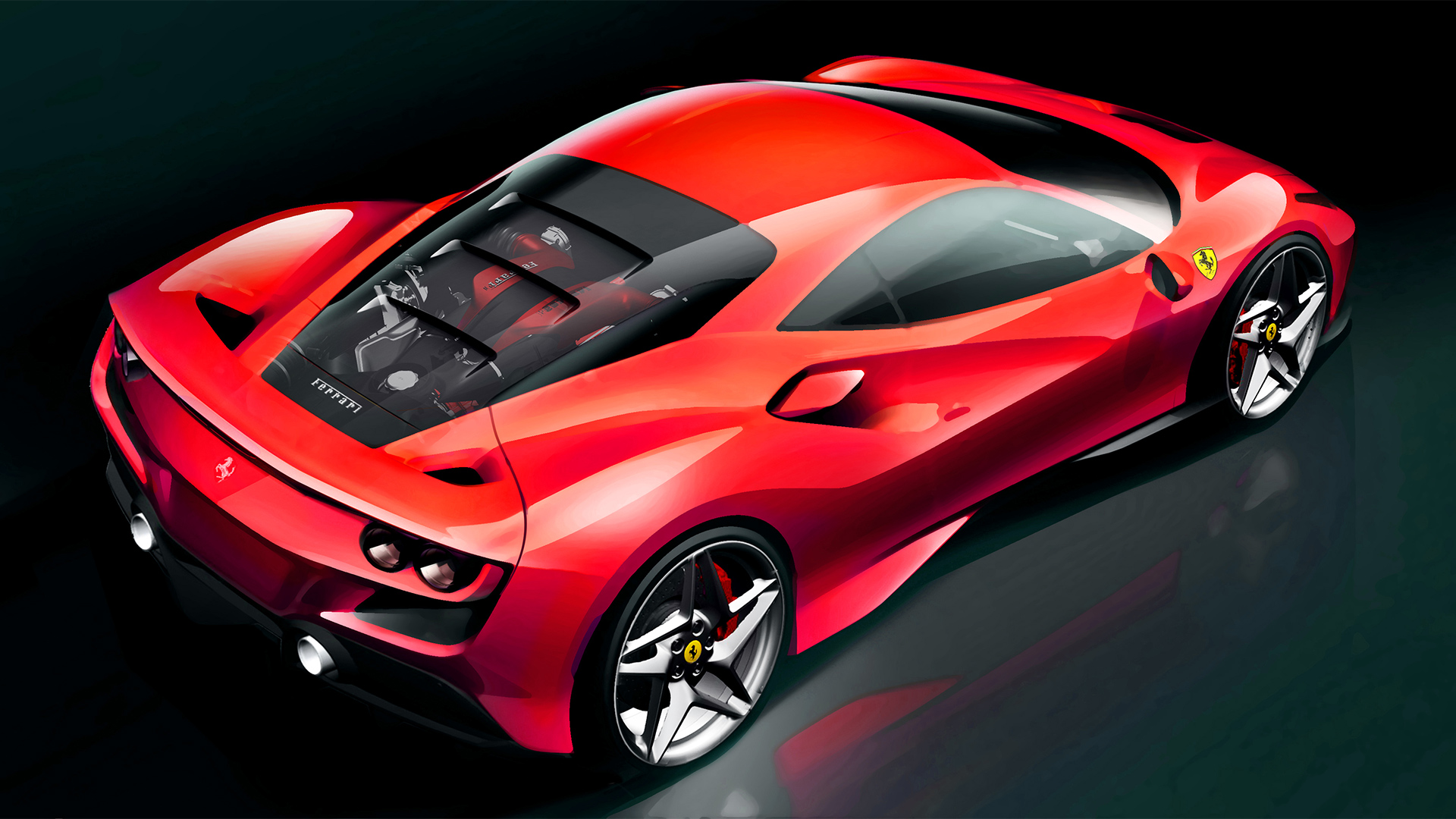LIVE FOR THE MOMENT

A CELEBRATION OF EXCELLENCE
The Ferrari F8 Tributo is the new mid-rear-engined sports car that represents the highest expression of the Prancing Horse’s classic two-seater berlinetta. It is a car with unique characteristics and, as its name implies, is an homage to the most powerful V8 in Ferrari history.
- CO2 Emission:
- Low: 490 g/km
- Mid: 276 g/km
- High: 246 g/km
- Extra High: 267 g/km
- Combined: 292 g/km
- Fuel consumption:
- Low: 21,5 l/100km
- Mid: 12,2 l/100km
- High: 10,8 l/100km
- Extra High: 11,8 l/100km
- Combined: 12,9 l/100km
The values of fuel consumptions and CO2 emissions shown were determined according to the European Regulation (EC) 715/2007 in the version applicable at the time of type approval.
The fuel consumption and CO2 emission figures refer to the WLTP cycle.
In order to be placed on the market, passenger cars carry out a series of tests to verify their compliance with regulations.

The tests to assess fuel consumption, CO2 and pollutant emissions are carried out in the laboratory and are based on specific driving cycles. In this way, the tests are reproducible and the results comparable. This is important because only a laboratory test, which follows a standardized and repeatable procedure, allows consumers to compare different car models. On 1 September 2017, the new Worldwide harmonised Light-duty vehicle Test Procedure (WLTP) came into force in Europe and will gradually replace the New European Driving Cycle (NEDC) protocol. NEDC (New European Driving Cycle): it has been the European driving cycle used so far for the measurement of fuel consumption and emissions from passenger cars and light commercial vehicles. The first European driving cycle came into force in 1970 and referred to an urban route. In 1992 it was also considered to have an extra-urban phase and since 1997 it has been used for measuring consumption and CO2 emissions. However, the composition of this cycle is no longer consistent with current driving styles and distances travelled on different types of roads. The average speed of the NEDC is only 34 km/h,
accelerations are low and the maximum speed is just 120 km/h. WLTP procedure: WLTP uses new Worldwide harmonised Light-duty vehicle Test Cycles (WLTC) to measure fuel consumption, CO2 and pollutant emissions from passenger cars and light commercial vehicles. The new protocol aims to provide customers with more realistic data, better reflecting the daily use of the vehicle. The new WLTP procedure is characterized by a more dynamic driving profile with more significant acceleration. The maximum speed increases from 120 to 131.3 km/ h, the average speed is 46.5 km/h and the total cycle time is 30 minutes, 10 minutes more than the previous NEDC. The distance travelled doubles from 11 to 23.25 kilometers. The WLTP test consists of four parts depending on the maximum speed: Low (up to 56.5 km/h), Medium (up to 76.6 km/h), High (up to 97.4 km/h), Extra-high (up to 131.3 km/h). These parts of the cycle simulate urban and suburban driving and driving on extra-urban roads and motorways. The procedure also takes into account all vehicle’s optional contents that affect aerodynamics, rolling resistance and vehicle mass, resulting in a CO2 value that reflects the characteristics of the single vehicle.

The WLTP procedure will gradually replace the NEDC procedure. The WLTP applies to new passenger car models from 1 September 2017, to all passenger cars registered from 1 September 2018 and is mandatory for all EU Member States. Until the end of 2020, both fuel consumption and CO2 emission values in WLTP and NEDC will be present in the vehicle documents. Indeed, NEDC values will be used to assess the average CO2 emissions of cars registered in the EU throughout 2020. In addition, some countries may continue to use the NEDC data for fiscal purposes. From 2021 onwards, WLTP data will be the only consumption/ CO2 emissions values for all cars. Used vehicles will not be affected by this step and will maintain their certified NEDC values.
ROAD CONSUMPTION AND EMISSIONS OF PASSENGER CARS
The new WLTP test procedure is more representative of current driving conditions than the NEDC procedure, but it cannot take into account all
possible cases including the effect of the driving style that is specific to each individual driver.
Therefore, there will still be a difference between emissions and consumption measured in the laboratory and those resulting from the use of the vehicle in the real world, and the extent of this difference will depend on factors such as driving behavior, the use of on-board systems (e. g. air conditioning), traffic and weather conditions that are characteristic of each geographical area and each driver. For this reason, only a standardized laboratory test allows to obtain values with which it is possible to compare vehicles and different models in a fair way.
WHAT CHANGES FOR CUSTOMERS
The new WLTP procedure will provide a more realistic criterion for comparing the fuel consumption and CO2 emission values of different vehicle models as it has been designed to better reflect real driving behavior and take into account the specific technical characteristics of the individual model and version, including optional equipment.

THE BEST ENGINE IN THE LAST 20 YEARS
- V8 TurboEngine
- 720 cvMaximum power
ADVANCED AERODYNAMIC SOLUTIONS
The front of the car is dominated by the S-Duct, an innovative aerodynamic solution adapted from Ferrari’s F1 experience and already used on the 488 Pista. Here it has been redesigned in function of the new front end design and accounts for 15% of the increase in overall downforce compared to the 488 GTB.
The duct takes the high pressure flow from the central section of the bumper and, thanks to specially calibrated sections, deflects it upwards through the vent on the bonnet. The variation in pressure generates downforce over the front axle. The position of the vent is designed to maximise the duct’s performance by exploiting the suction generated by the curvature of the surfaces, maximising the amount of air that passes through the S-Duct.

It was only through close synergy with the Ferrari Styling Centre that the strict aerodynamic constraints could be so flawlessly interpreted and integrated into the car’s design. New, more compact, horizontal LED headlights allowed Ferrari’s aerodynamicists to incorporate new brake cooling intakes in combination with those on the outside of the bumper, the aim being to improve air flow throughout the entire wheelarch.

The signature element at the rear of the car is the blown spoiler. Originally patented for the 488 GTB, it was radically modified to produce a much more extreme version for the 488 Pista. The challenge facing the aerodynamics in the development of the F8 Tributo was improving rear downforce without increasing drag or interfering with the harmonious forms of this area of the car.
The blown spoiler’s calibrated sections work in synergy with the suction generated by the spoiler to create upwash which accounts for 25% of the increase in downforce compared to the 488 GTB. Contemporaneously, three turning vanes inside the blown spoiler effectively recompress the flow towards the wake of the car, reducing drag by 2% and compensating for the knock-on effect of the increase in downforce.

The front radiator layout is totally different to the 488 GTB. On the F8 Tributo, the radiator packs are tilted towards the rear, using the flat undertray to channel the hot air and minimise the thermal interaction with the flows inside the wheel arch. This improved management of cooling flows reduces the temperature of the air entering the plenum by 15°, further increasing power.

AERODYNAMIC PERFORMANCE NEVER ACHIEVED BEFORE
The F8 Tributo features state-of-the-art aerodynamics, integrating innovations and expertise developed thanks to the company’s involvement in the GT and Challenge championships. The solutions have been honed to create a series-production mid-rear-engined berlinetta with the highest level of performance available.
DRIVING AT THE LIMIT WITH EASE AND CONFIDENCE
EXCEPTIONAL AND EASILY ACCESSIBLE PERFORMANCE
To achieve their goal of making the car’s impressive performance easy to access and use, Ferrari’s engineers worked on integrating engine and aerodynamics performance with the latest iteration of the vehicle dynamics control systems.The Side Slip Control system, which improves drivers’ control on the limit for even more engaging involvement, has been further evolved. The transition from version 6.0 to 6.1 reflects the fact that the Ferrari Dynamic Enhancer system now also activates in the manettino RACE (FDE+) position.
CLEAN AND DECISIVE LINES
The car is also offered with new (optional) forged starburst wheel rims, and thus asymmetrical on the two sides, lending an air of dynamism and sportiness.

The new rear screen celebrates Ferrari’s legendary V8 engine. Made from ultralight Lexan®, it has been restyled to incorporate three louvres at it centre and showcase the engine compartment, bringing a modern twist to the most distinctive design element from Ferrari’s most famous V8-engined car, the F40. The louvres also help extract hot air from the engine compartment, in line with Ferrari’s focus on functional design.
[image src="https://cdn.ferrari.com/cms/network/media/img/Hotspot-img1-lunotto_ntitnSs4.jpg?apikey=gxEn89eMkieLdSzFrR31mWslcgRpLCpZ"]

The rear of the car has also been strongly influenced by the car’s new styling. Aside from the rear screen, the spoiler has been entirely redesigned. It is now larger and wraps around the tail lights, visually lowering the car’s centre of gravity and allowing a return to the classic twin light cluster and body-coloured tail, another signature of the early 8-cylinder berlinettas like the very first in the legendary series, the 308 GTB.

Designed by the Ferrari Styling Centre, the F8 Tributo is essentially a bridge to a new exterior design language. From the very earliest stages of the design process, the work focused on two goals simultaneously: designing a stylistic tribute to the Ferrari V8 engine, inspired by the most iconic mid-rear-engined V8 sports cars in Ferrari history, and giving the car a strong personality of its own through an even sportier design clearly inspired by the car’s advanced aerodynamics.

A lot of attention was paid to ensuring that the Maranello marque’s signature styling elements were respected even while seamlessly incorporating the aerodynamic elements into the design and then underscoring them with clean yet decisive lines.
The front of the car is characterised by the S-Duct around which the entire front end has been redesigned to highlight the extensive aerodynamic modifications made to this area of the car. The clearest example is new, more compact, horizontal LED headlights. Thanks to its more compact size, the classic L-shape is created not by the continuation of the headlights but by an aerodynamic intake.
The front is completed by side aerodynamic intakes which are integrated into the shape of the bumper and feature two aerodynamic side splitters in black which create a visual link rearwards behind the wheel and onto the exterior sill covers.
The car’s flanks are dominated by the evident muscular forms of the front and rear wheelarches which give the impression that the bodywork has been tightly moulded around the running gear with no space left over for non-functional stylistic motifs or voids. The shape of the side air intakes for the intercooler has been redesigned too, highlighting one of the most important stylistic motifs from Ferrari mid-rear-engined V8 history.


From the track to street



NEW COCKPIT-STYLE INTERIORS
The cockpit retains the classic, driver-oriented look typical of Ferrari’s mid-rear-engined berlinettas. Every element of the dash, door panels and tunnel has been completely redesigned specifically for the car. The F8 Tributo also boasts a new generation steering wheel and steering wheel-mounted controls as well as new styling on the standard seats.
Balanced
Partners
- 3M
- APPLE
- APTIV
- BOSCH
- BREMBO
- CBS
- DTS
- FAURECIA
- FONTANA
- IHI
- LEAR
- MAGNA TS
- MAGNETI MARELLI
- MAHLE
- MICHELIN
- NOVATION
- OMR
- PIRELLI
- SABELT
- SAINT GOBAIN
- SHELL
- SOLVAY
- ZF
- engine
- Aerodynamics
- dynamics
- design
- CARBON FIBRE RACING RIMS
- Interior
- Stories
- Technical Details
- Media Gallery



